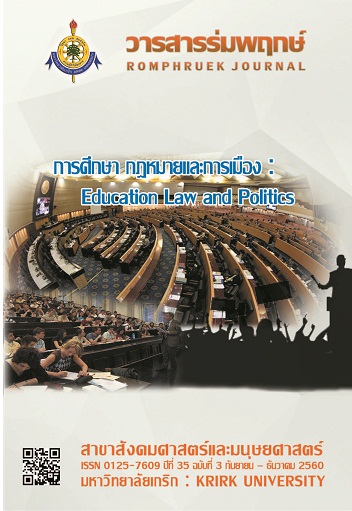Development of Teacher Preparation Model to Serve Education 4.0
Main Article Content
Abstract
This study is a descriptive research. The main research objective is to develop teacher preparation model for education 4.0. The research procedures included analyzing essential competencies for teachers in education 4.0; analyzing strengths and weaknesses of current teacher preparation in Thailand; and analyzing successful teacher preparation at the international level. Then, develop a draft of the teacher preparation model for education 4.0, which was reviewed by experts. Research findings showed that essential competencies for teachers in education 4.0 era were composed of 10 core competencies for education 4.0 and six professional teacher competencies. Strengths and weaknesses analysis of current teacher preparation in Thailand revealed more weaknesses than strengths. Meanwhile, findings from the analysis of teacher preparation in Finland and Singapore provided good lessons for Thailand. Teacher preparation model for education 4.0, derived from this study was entitled, Professional and Innovativeness Enhancement Teacher Education Model, composed of eight core elements.
Article Details
Every article published in the Romphruek Journal of the Humanities and Social Sciences is the opinion and point of view of the authors. Thery're not the viewpoint of Krirk University or the editored department. Any part or all of the articles for pablication must be clearly cited.
References
กฤตธี วงศ์สถิต. (2560). 7 องค์ประกอบหลักสูตรโรงเรียนผลิตภาพ.ในไพฑูรย์ สินลารัตน์ (บรรณาธิการ),โรงเรียน 4.0 : โรงเรียนผลิตภาพ (45-58). กรุงเทพฯ : วิทยาลัยครุศาสตร์ มธบ.
เฉลิมชัย มนูเสวต (2559). 24/7…ทุกคน ทุกวิชา ทุกภาคการศึกษา. ใน ไพฑูรย์ สินลารัตน์(บรรณาธิการ), การศึกษา 4.0 เป็นยิ่งกว่าการศึกษา(206-209). กรุงเทพฯ : วิทยาลัยครุศาสตร์ มธบ.
ชนิตา รักษ์พลเมือง. (2559). การศึกษาสภาพและปัญหาการผลิต การใช้ และการพัฒนาครูการศึกษาขั้นพื้นฐานที่สอดคล้องกับความต้องการในอนาคต. กรุงเทพฯ : สำนักงานเลขาธิการคุรุสภา.
ญาดา นิลประดิษฐ์. (2553). การเปรียบเทียบกิจกรรมเสริมความเป็นครูของนักศึกษาครูในมหาวิทยาลัยที่แตกต่างกัน : การวิจัยแบบผสม. คณะครุศาสตร์ จุฬาลงกรณ์มหาวิทยาลัย, กรุงเทพฯ.
ดิเรก พรสีมา. (2559). ครูไทย 4.0. (4 พฤศจิกายน 2560). สืบค้นจาก https://www.matichon.co.th/news.
พิมพ์พันธ์ เดชะคุปต์ และ พรทิพย์ แข็งขัน. (2551). สมรรถนะครูและแนวทางการพัฒนาครูในสังคมที่เปลี่ยนแปลง. กรุงเทพฯ : สำนักงานเลขาธิการสภาการศึกษา กระทรวงศึกษาธิการ.
พิมพ์พันธ์ เดชะคุปต์ และ พเยาว์ ยินดีสุข. (2560). ทักษะ 7 C ของครู 4.0. กรุงเทพฯ : โรงพิมพ์แห่งจุฬาลงกรณ์มหาวิทยาลัย.
เพชรสุดา ภูมิพันธุ์. (2560). หลักสูตรศึกษาศาสตร์/ครุศาสตร์ จะไปในทิศทางใด. ใน ไพฑูรย์ สินลารัตน์ และนักรบ หมี้แสน (บรรณาธิการ). ครุศึกษาและการพัฒนาวิชาชีพครู. (31-45). กรุงเทพฯ : สำนักพิมพ์จุฬาลงกรณ์มหาวิทยาลัย
ไพฑูรย์ สินลารัตน์. (2559). การศึกษา 4.0 เป็นยิ่งกว่าการศึกษา. ศูนย์ตำราและเอกสารวิชาการวิทยาลัยครุศาสตร์ มธบ.
ยืน ภู่วรวรรณ. (2558). นวัตกรรมการเรียนการสอนกับการศึกษาระบบ4.0. วารสารเทคโนโลยีสุรนารี, 9(2), 133-156.
ราชบัณฑิตยสถาน, สำนักงาน. (2555). พจนานุกรมศัพท์ศึกษาศาสตร์. กรุงเทพฯ : อรุณการพิมพ์.
รสสุคนธ์ มกรมณี. (2553). การฝึกหัดครูของประเทศฟินแลนด์. วารสารการศึกษาไทย. 7(71), 33-38.
ฤตินันท์ สมุทร์ทัย และคณะ. (2556). การวิจัยนำร่องการพัฒนาหลักสูตรการผลิตครูสำหรับศตวรรษที่ 21. มหาวิทยาลัยเชียงใหม่.
เลขาธิการสภาการศึกษา, สำนักงาน. (2558). สถานภาพการผลิตและพัฒนาครูในประเทศไทย. กรุงเทพฯ : บริษัทพริกหวานกราฟฟิค จำกัด.
วิชัย วงษ์ใหญ่. (2554). การพัฒนาหลักสูตรระดับอุดมศึกษา. กรุงเทพฯ : อาร์ แอนด์ เอ็น ปริ้นท์ จำกัด
ศักดิ์ชาย เพชรช่วย. (2558). อนาคตภาพการผลิตครูของสถาบันอุดมศึกษาไทย. คณะครุศาสตร์ จุฬาลงกรณ์มหาวิทยาลัย, กรุงเทพฯ.
ศุภณัฏฐ์ ศศิวุฒิวัฒน์. (2559). รายงานชุดการปฏิรูประบบบุคลากรค รู: ข้อเสนอการสร้างและคัดเลือกครูสอนดีรุ่นใหม่สู่การยกระดับคุณภาพการศึกษา. กรุงเทพฯ : สถาบันวิจัยเพื่อการพัฒนาประเทศ.
สมเกียรติ ตั้งกิจวานิชย์ ปกป้อง จันวิทย์ ดิลกะ ลัทธพิพัฒน์ ภาวิน ศิริประภานุกูล ภูมิศรัณย์ ทองเลี่ยมนาค วรพจน์ วงศ์กิจรุ่งเรือง ศุภณัฎฐ์ ศศิวุฒิวัฒน์. (2556). การจัดทำยุทธศาสตร์การปฏิรูปการศึกษาขั้นพื้นฐานให้เกิดความรับผิดชอบ. กรุงเทพฯ : มูลนิธิสถาบันวิจัยเพื่อพัฒนาประเทศ.
สุวิทย์ เมษินทรีย์. (2559). พิมพ์เขียวและแผนปฏิบัติการขับเคลื่อน:Thailand 4.0 โมเดลขับเคลื่อนประเทศไทยสู่ความมั่นคง มั่งคั่งและยั่งยืน.
อเนก เทียนบูชา (2559). หลักสูตรระดับอุดมศึกษาที่มุ่งเน้นสมรรถนะ. วารสารจันทรเกษม, 22(43), 33-47.
อนุภาพ เลขะกุล. (2550). การเรียนรู้โดยใช้ปัญหาเป็นฐาน. ใน ไพฑูรย์ สินลารัตน์ (บรรณาธิการ), อาจารย์มืออาชีพ : แนวคิด เครื่องมือและการพัฒนา (66-73). กรุงเทพฯ : ควอท.
อนุสรณ์ นามประดิษฐ์. (2560). 7 วิธีการวัดและประเมินผลโรงเรียนผลิตภาพ. ใน ไพฑูรย์ สิลารัตน์ (บรรณาธิการ), โรงเรียน 4.0 : โรงเรียนผลิตภาพ (105-112). กรุงเทพฯ : วิทยาลัยครุศาสตร์ มธบ.
Berry, B., Byrd, A., & A. Wieder (2013). Teacherpreneurs: Innovative Teachers Who Lead But Don’t Leave. CA : Jossey-Bass.
Boss, S. (2012). Bringing Innovation to School : Empowering Students to Thrive in a Changing World. Bloomington : Solution Tree Press.
Claudia, C. (2014). The Role of Extracurricular Activities and Their Impact on Learning Process. (18 Sept. 2017). Retrieved from http://steconomiceuoradea.ro/volume/2014/.pdf.
Council of Chief State School Offices (CCSSO). (2013). Interstate Teacher Assessment and Support Consortium In TASC Model Core Teaching Standards and Learning Progressions for Teachers1.0. Washington, DC : Author.
Couros, G. (2015). The Innovator’s Mindset. CA : Dave Burgess Consulting, Inc.
Curth, A. (2011). Mapping of Teachers’ Preparation for Entrepreneurship Education. (18 September 2017). Retrieved from https://www.ab.gov.tr/files/ardb/evt/1_avrupa_birligi/1_9.../mapping_en.pdfDarling-Hammond,
L. (2006). Constructing 21st-century teacher education. Journal of Teacher Education, 57(5), 1-15.
European Commission(EC). (2013). Supporting teacher competence development for better learning outcome. (18 September 2017). Retrieved from http://ec.europa.eu/dgs/ education_culture/repository/education/policy/school/doc/teachercomp_en.pdf.
Ingersoll, R.M., (Eds.). (2007). A comparative study of teacher preparation and qualifications in six nations. PA, Philadelphia : Consortium for Policy Research in Education.
JISC. (2006). Designing spaces for effective learning : A guide to 21 century learning space design. (28 January 2017). Retrieved from http://www.jisc.ac.uk/media/documents/ publications/llearningspaces.pdf.
Korthagen, F., Loughran, J. & Russell, T. (2006). Developing fundamental principles for teacher education program and practices. Teaching and Teacher Education, 22, 1020-1041.
Lonka, K., Hietajavi, L., Moisala, M., Tuominen-Soini, H., & Vaara, J. (2015). Innovative schools: Teaching & learning in digital era. (28 January 2017). Retrieved from http://www
.europarl.europa.eu/thinktank/en/document.html?reference=IPOL_STU(2015)563389.
National Institute of Education (NIE) (2009) TE21: A teacher education model for the 21 st century. Singapore : NIE.
Neimi, H. (2013).The finish teacher education, teachers for equity and professional autonomy. Revista Espanola de Educacion Comparada, 22, 117-138.
Ruissmaki, J., Salomaa, R., & Ruokonen, I. (2015). Minerva Plaza- a new technology-rich learning environment. Procedia : Social and Behavioral Sciences, 171, 968-981.
SEAMEO INNOTECH (2010). Teaching competency standards in Southeast Asian Countries. (28 January 2017). Retrieved from http://seameo-innotech.org.
Stopsky, F. (2016). Towards the Fourth Revolution in Education. XLIBRIS.
Thorsteinsson, G. (2013). Ideation training via innovation education to improve students’ ethical maturation and social responsibility. Journal on Education Psychology, 6(4), 1-7.
Vidovic, V.V. & Velkovski, Z. (ed.). (2013). Teaching profession for the 21st Century : Advancing Teacher Professionalism for Inclusive, Quality and Relevant Education-ATEPIE. Belgrade : UNESCO Centre for Education Policy.
Wagner, T. (2012). Creating innovators: The making of young people who will change the world. NY: Scribner.
World Economic Forum. (2016). The 10 skills you need to thrive in the Fourth Industrial Revolution. (28 January 2017). Retrieved from https://www.weforum.org/agenda/2016/01/the-10 skills-you need-to-thrive-in-the-fourth-industrial-revolution.
Zao, Y. (2012). World class learners: Educating creative and entrepreneurial students. California : Cowin.


